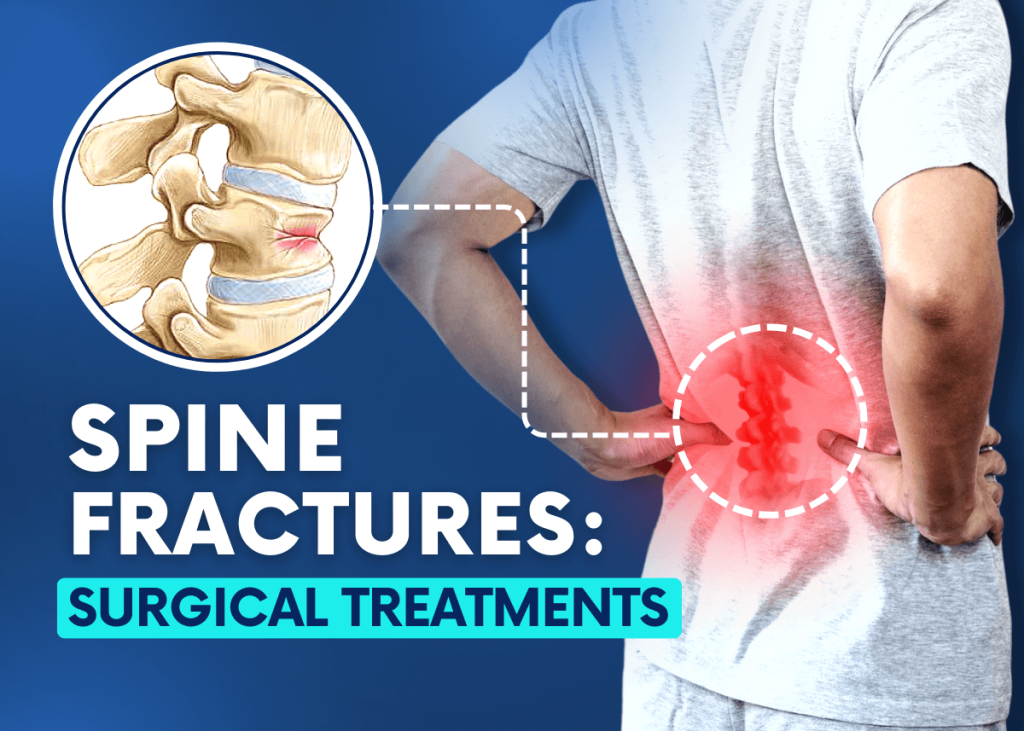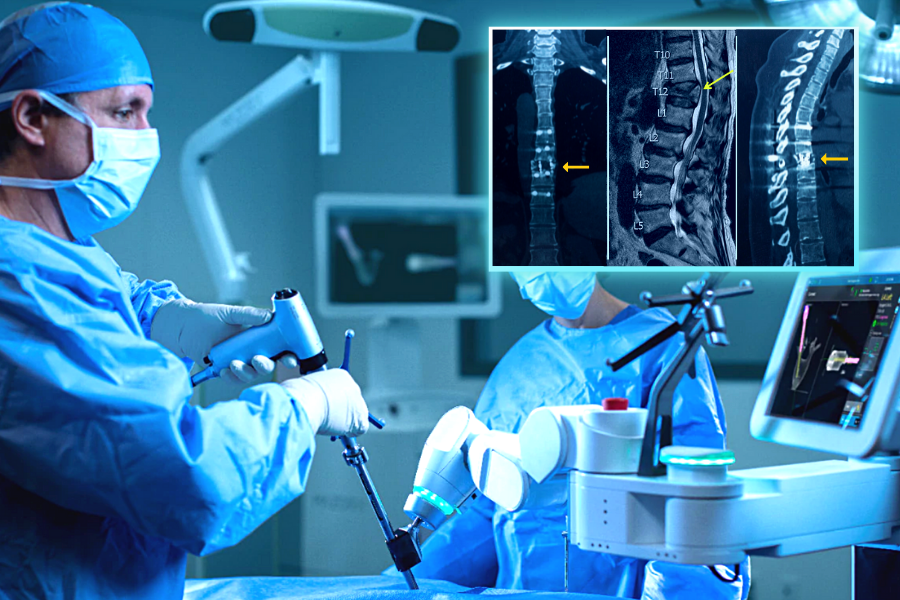
Spinal fractures not only cause pain and limited mobility, but can also lead to serious conditions such as spinal cord and nerve root damage. This is why spinal fractures should be treated differently from other injuries, such as broken arms or legs.
Spinal fractures are usually caused by injuries and trauma from car accidents, falls from height, sports accidents or high-speed impacts. The treatment plan varies according to the location and severity of the fracture.
Most of the time, non-surgical treatments such as the use of a corset may be sufficient for spinal fractures. However, some vertebral fractures may require spinal fracture surgery to realign the bones and relieve spinal cord compression. If these fractures are not treated in time, they can cause permanent spinal cord injury, nerve damage and paralysis.
Today, the robotic spine surgery method has been developed, which allows spine surgeries to be performed with the highest accuracy, precision and safety. This advanced technological method, which is revolutionary in modern orthopedic applications, has started to be applied for the first time in Turkey in our Turan&Turan Bone Muscle Joint Health Center in Turkey after a few centers in the world. You can contact us for information about Robotic Spine Surgery or send your message using the contact form.
Table of Contents:
- What is a Spine Fracture?
- What is a Lumbar Fracture?
- What are the Types of Spine Fractures?
- What Causes Spine Fractures?
- What happens if the spine bone is broken?
- What are the Symptoms of a Spine Fracture?
- How to Diagnose a Fracture in the Spine?
- How are Spine Fractures Treated?
- Spine Fracture Surgery
- Spine Fracture Surgery with Robotic Spine Surgery
What is a Spine Fracture?
The human spine is the structure that forms the main support of the body and enables movements such as standing upright and bending over. The spine is made up of 33 bones called vertebrae, which are stacked on top of each other. Fractures that occur in the bones of the spine as a result of trauma caused by accidents and injuries or other causes such as osteoporosis (osteoporosis) are known as spinal fractures ( Picture 1).

Spinal fractures can occur in a variety of presentations ranging from mild muscle and ligament injuries to severe fractures and dislocations. The spine is basically divided into three parts: cervical vertebrae, dorsal vertebrae and lumbar vertebrae. These are followed by the sacral vertebrae extending to the coccyx and the coccyx, which we call the coccyx.
Spinal fractures can occur in one or more vertebrae anywhere in the spine. Spinal fractures are also known as lumbar fractures because they are most common in the lumbar region.
What is a Lumbar Fracture?
Another common term used to describe a spinal fracture is lumbar fracture. Fractures of the vertebrae in the lumbar region are known as lumbar fractures. Traumatic injuries caused by collisions, especially car accidents, can cause a broken back. Weakening of the bones due to osteoporosis (osteoporosis) or tumor formation is also a cause of back fractures.
What are the Types of Spine Fractures?
There are many different classifications of spinal fractures. Basically, it can be expressed as fractures, dislocations and fractured dislocations (Picture 2).
Fractures
Fractures can occur when the bones of the spine are exposed to more load and pressure than they can withstand. The most common type of spinal fracture is a compression fracture, also known as a vertebral compression fracture.
It is often caused by conditions such as osteoporosis (osteoporosis) or tumors that cause bones to weaken. In this type of fracture, the front part of the vertebra is broken and its height decreases, while the back part remains stable. This type of compression fracture results in the shape of the vertebra being wedge-shaped rather than square. In this case, a deformity called kyphosis, in which the spine bends forward, is formed.
A fracture can also occur as a result of a vertical impact on the spine, such as falling from a very high place onto your feet. In this type of trauma, the height of both anterior and posterior vertebrae is reduced. Severe fractures of this type, which cause flattening of the vertebrae, can cause compression of the spinal cord or nerve tissue.
Dislocations
As a result of excessive stretching or tearing of the ligaments and discs that connect the spinal bones, the spinal bones can slip out of their normal alignment. These dislocations can cause narrowing of the spinal canal and spinal cord damage.
Fracture dislocations
Dislocations with fractures in the vertebral bones and slippage in the spine caused by tears in the ligaments are referred to as fracture dislocations. This type of traumatic injury usually requires surgical treatment.

What Causes Spine Fractures?
The most common cause of spinal fractures is exposure to high-speed and violent impacts, such as car accidents. Spinal fractures can also occur due to osteoporosis, tumors or other underlying conditions that weaken the bone. These people can fracture their back and lumbar vertebrae even with a slight impact or low-impact movement such as lying down.
The causes of spinal fractures are generally as follows:
- Car accidents, bumps and falls,
- Falling from a height,
- Sport accidents,
- Spine tumors,
- Osteoporosis (bone resorption)
In addition, serious infections can weaken bones and cause fractures. Malnutrition, weak immune system, cancer and obesity are also factors that can increase the risk of fractures.
What happens if the spine bone is broken?
Fractures of the spine are different from other fractures, such as those of the arm or leg bone. In the canal in the middle of the vertebrae is the spinal cord, which provides nerve transmission from the brain to all parts of the body. The spinal cord is a long cord-like structure with nerve pathways that control the entire limbs and trunk. This delicate and vital structure passing through the spine increases the severity of spinal fractures.
Damage to the spine can range from mild ligament and muscle injuries to fractures, dislocations and severe spinal cord and nerve damage (Picture 3). Depending on the severity of the damage, back pain, difficulty walking, weakness, loss of feeling in the arms and legs or inability to move them (paralysis) may occur. Hunchback (kyphosis) can also occur, especially if the fracture has caused collapse and wedging of several dorsal vertebrae.

In some minor spinal fractures, non-surgical treatment methods such as bracing and rest are beneficial. However, spine surgery is recommended to help relieve pressure on the spinal cord and stabilize the spine.
What are the Symptoms of a Spine Fracture?
The most common symptom of a spinal fracture is sudden pain in the lumbar and back area that worsens with movement. If the broken bone compresses the spinal cord and nerves, there may be localized numbness as well as pain.
If the nerve roots or spinal cord are severely damaged by the pressure of the broken bone, sensation, reflexes, muscle strength and movement can be affected. Nerve damage can also lead to problems such as loss of bladder and bowel control.
Symptoms of a spinal fracture are usually as follows:
- Low back, back or neck pain aggravated by movement,
- Tingling, numbness or weakness in the limbs,
- Muscle spasms
- Bowel and bladder problems,
- Loss of movement in the arms and legs,
- Loss of consciousness-fainting in severe fractures.
It is extremely important to seek emergency medical help, especially in serious cases of loss of consciousness and loss of movement. Here, the person should be properly supported without moving and the emergency team should be called. It should not be forgotten that an unconscious movement can lead to spinal fracture, damage to the spinal cord and paralysis..
How to Diagnose a Fracture in the Spine?
A spinal fracture is diagnosed after physical examination and evaluation of radiological findings. During the physical examination, the doctor performs a detailed examination, including the head, abdomen, pelvis, limbs and spine, and listens to the person’s complaints. The presence of an accident that could cause a fracture or conditions that weaken the bones, such as osteoporosis, is assessed. Radiological examinations such as X-rays, computed tomography (CT) and magnetic resonance imaging (MRI) can detect conditions such as fractures, changes in bone structure and alignment or soft tissue damage.

How are Spine Fractures Treated?
Depending on the location of the fracture and the degree of instability of the spine, the treatment of spinal fractures is determined. Fracture treatment starts with stabilizing the person to prevent further spinal damage. For this purpose, a back support or cervical collar is used to stabilize the spine.
The treatment plan depends on the severity of the fracture. Spinal fracture surgery may not always be necessary. In some spinal fractures, non-surgical methods such as the use of a corset can be useful.
Many fractures, including vertebral collapse fractures due to osteoporosis, can be treated with the use of a brace for 6-12 weeks. Physical therapy and exercises are then applied to gradually increase the person’s physical activity. If there is a fracture of the cervical vertebrae (neck vertebrae), a neck brace may be recommended (Picture 5).

However, if there is a serious fracture of the spine or nerve and spinal cord injury, spinal surgery is needed.
Spine Fracture Surgery
Fractures of more than one vertebra or fractures with significant nerve damage due to spinal cord compression require spinal fracture surgery. Fractures that are not treated early can result in serious conditions such as paralysis. In addition, surgical treatment is often required in cases where the fracture has reduced the height of the spine, making it unstable and loss of load-bearing function.
There are different spine surgery methods and the type of surgery is determined according to the type of fracture. In most cases, broken bone fragments need to be removed as they can damage the spinal cord and nerve roots.
The standard surgical methods commonly used for spinal fracture surgery are
Spinal fusion: A surgical procedure for the treatment of unstable spinal fractures. In spinal fusion, two or more vertebrae are joined together to form a single bone.
The vertebrae are permanently joined together using various tools such as surgical implants, screws, cages and bone graft. This aims to stabilize the spine and reduce complaints such as pain. It can take months to achieve a solid fusion.
Vertebroplasty/Kyphoplasty: Vertebroplasty or kyphoplasty are surgical procedures for collapse fractures caused by osteoporosis or spinal tumors. A needle called a trocar is inserted into the broken bone in the spine. A balloon is inflated to expand the collapsed vertebrae and return the vertebra to its normal height.
Bone cement is then injected into the fractured vertebral body. The procedure is called vertebroplasty only if bone cement is used and kyphoplasty only if a balloon is used. When this method is applied at an early stage in spinal fractures caused by osteoporosis, the pain is rapidly controlled and hump formation is prevented.
Recovery period after spine fracture surgery
The recovery period for spinal fractures after surgery varies depending on the type of surgical procedure performed and the patient’s condition. Today, thanks to the advanced technologies and modern orthopedic practices used in spine surgeries, the healing process can be faster and painless.
Physical therapy and rehabilitation is one of the most important steps after spinal fracture surgery. Physical therapy is the most important condition to reduce pain, regain mobility and return to normal life as quickly as possible. In addition, post-operative spinal fractures may require the use of corsets that partially restrict spinal movements during the healing process. If the spinal fracture has caused spinal cord injury and the patient develops paralysis, a long-term physical therapy and rehabilitation program is required after surgery.
After spine surgery, patients’ mobility and activities are gradually increased. Bones need 6-12 weeks to 6 months to heal. During this process, it is extremely important for the patient to pay attention to what they should and should not do.
Furthermore, if the cause of the spinal fracture is osteoporosis, the patient is at high risk of re-fracture. Therefore, additional treatments and observation during the recovery process are recommended.
What are the Risks of Spine Fracture Surgery?
The aim of spinal fracture surgery is to return the bones to their normal alignment and relieve pressure on the nerves and spinal cord. For this purpose, surgical instruments such as surgical screws, rods and cages are used during surgery. However, spine surgeries are complex and require high precision, as it is an extremely sensitive area located close to the spinal cord and main blood vessels.
Some of the risks of spinal fracture surgery include
- Anesthesia complications
- Infection
- Deep vein thrombosis (DVT)
- Risks associated with the lungs
- Vascular injury (artery and vein injury). An injury to the body’s main artery, such as the aorta, is life-threatening.
- Partial weakness or paralysis due to nerve and spinal cord injury
The risk of nerve and spinal cord injury, especially in spine-related surgical procedures, can lead to serious complications such as paralysis in patients. In addition, the spine is located very close to major blood vessels such as the aorta. Injury to these vital vessels during surgery can result in death. The risks of spine surgery should be explained to the patient before surgery.
Thanks to the use of appropriate surgical techniques and modern technologies, it is now possible to avoid these risks. One of the newest and most reliable technologies in spine surgery is robotic spine surgery, which is now used in a number of centers around the world.
Spine Fracture Surgery with Robotic Spine Surgery
Robotic spine surgery is one of the modern orthopedic applications that provides high precision and reliability in spine surgeries. Surgical screws are often required to stabilize the spine during spinal fracture surgery. However, in order to avoid risks such as nerve damage, paralysis, injury to the main blood vessels of the body and for the surgery to be successful, the screw must be placed in the spine in the right size and at the right angles. Otherwise, structures such as the spinal cord and blood vessels near the spine can be damaged, resulting in paralysis or even death.
In addition, if the screws are not placed in exactly the appropriate position, it causes more load on the screw over time and damage to the screws may occur due to material fatigue. This can lead to a second corrective surgery called revision surgery. Robotic spine fracture surgery is an advanced technology developed to prevent these risks.
With the robotic surgical system, surgeons can make a 3-dimensional and detailed plan before surgery. The angle and size of the implants are planned and prepared with precise technical measurements before the surgery is performed.
During the operation, the angle, position and movement of the screw in the spine are monitored on the screen with real-time imaging. The robotic spine system, which enables the surgical procedure to be performed in accordance with the plan with high precision and accuracy, emphasizes patient safety. In this way, with a predictable planning, precise and accurate surgical procedures are performed in accordance with the vertebral structure of each patient.

Spinal fracture surgeries can be performed with robotic surgery. Robotic Spine Fracture Surgery is performed with high precision and reliability in the most appropriate way for the patient anatomy.
Methods such as spinal fusion and vertebroplasty applied in spinal fracture surgery can be performed with high reliability in robotic spinal fracture surgery. Some of the advantages of spine fracture surgery with robotic robotic surgery system are as follows:
- Over 99.5% accuracy in screw placement in the spine,
- Higher patient safety with less risk of complications,
- Planning according to the patient’s unique anatomy,
- Shorter hospital stays,
- Faster and more painless recovery,
- Less tissue trauma.
Robotic spine surgery is now used in leading clinics around the world. For the first time in Turkey, it is offered to our patients in our Turan&Turan Bone Muscle Joint Health Center in Turkey.
We provide services in the treatment of spinal fractures and all problems related to spinal health with the most up-to-date technology and treatment methods. The safety of our patients is our priority…









Leave a Comment